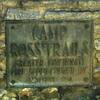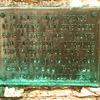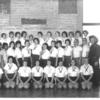Camp Ross Trails - History and Memories
History of the Camp
History
(as published by the Great Rivers Girl Scout Council)
In 1956, 305 acres were purchased in Ross Township, Butler County, **** Layhigh Road. The purchase was made possible by the sale of cookies. The camp was formally dedicated as Camp Ross Trails on May 24, 1959.
A combination dining and recreation building was completed in 1960 and named Bullock Lodge in honor of John R. Bullock, General Chairman of the 1957 Fund Drive to raise money for permanent buildings.
By June 1960, 11 units and a Z-shaped swimming pool were ready for campers. A small pond had been enlarged to a twelve acre lake for a boating program.
Between 1981 and 1983, major improvements to the camp included a new horse barn with two riding rings, installation of indoor shower facilities and access facilities for the handicapped at both Totem and Fox Den Lodges, and remodelling of a unit to provide "Prairie Schooners" and teepee kitchen shelter.
(Editor's Note: The address on Layhigh has been removed to protect the current owners of the property.)
The Cincinnati Post-Times Star
Tuesday, August 26, 1958
Girl Scouts Seek $425,000 for Camp
Growing Membership Prompts First Funds Appeal in 31 Years
The girls scouts who have been paddling their own financial canoes around here for 31 years are finally asking for help.
They’ll open a two-month campaign Nov. 15 for $425,000. That’s the minimum. They’d like to get $500,000.
“What? Why?” you ask. “Don’t they get money from the Community Chest?”
True enough, the Greater Cincinnati Girl Scout Council, Inc., which includes Hamilton and Clermont counties, is receiving $65,000 from the Chest this year - to operate existing facilities.
BUT, THE COUNCIL is growing - it now includes 1012 troops and 16,837 girls - and, leaders contend, desperately needs another camp. That’s the purpose of the girl scouts’ first capital funds appeal.
A 300-acre site has been purchased. The money is needed to complete it.
The campaign will be limited, with solicitations sought from about 750 industries and their executives and the parents of girl scouts.
It’s headed by John R. Bullock, chairman, and Mr. and Mrs. Edwin H. Leedy, co-chairmen, who are in charge of the girl scout family solicitation committee. Mrs. Dorothy Lammers is executive secretary for the drive.
The council, incidentally, is the second oldest in the country, having been established in 1917 with Mrs. Max Hirsch as the first president.
HERE ARE SOME facts the girl scout leaders cite as reasons for needing the new camp:
They have only one such facility, Camp Butterworth, at Foster’s Crossing, in operation since 1930.
Although it is one of the finest camps in this part of the country, Camp Butterworth is just too small. It comprises only 140 acres. It can accommodate only 700 girls during the 10 two-week camping periods during the summer.
Difficulty in obtaining a suitable water supply make doubtful that another site - a 225-acre plot in Clermont county recently donated by Mrs. Grace E. Groesbeck - can ever be used as a permanent camp site.
Hundreds of girls are denied camping facilities every summer. Only about 4 percent of the active scouts can attend Butterworth.
The proposed new campsite, on which improvements have been started, is in Butler county, a little more than a mile north of Ross.
Work on the No. 1 camp project, a 10-acre lake, was begun Friday when workmen under ... contractor for the lake, and Al Windholtz, subcontractor, began cleaning a wooded area.
C.H. Allendorf & Associates, consulting engineers, are the general contractors.
SELECTED AFTER a three-year search, it’s ideal for scout purposes. The land is rolling and wooded, even includes a lake.
When completed, the new camp is expected to provide summer camping for about 1200 girls. In addition, construction will be of the type so that the site can be used year-around for troop trips, cookouts, campings and hikes. This means that about 12,000 girls will be using it during the course of a year.
The only problem is the cost - between $625,000 and $700,000. And that’s the reason for the $25,000 campaign.
The other $200,000? That’s already been raised by the girl scouts themselves through cookie sale profits accumulated over many years.
(... Parts of this article are missing due to a blurred copy of the original article.)
The Cincinnati Post-Times Star
Tuesday, May 26, 1959
Additions To Be Built At Girl Scout Camp
Work will begin soon in a swimming pool, dining hall and facilities for eight more units of a new Girl Scout camp. The 304-acre camp site is at 3459 Layhigh road in Ross Township, Butler County, 25 miles from downtown Cincinnati.
Three units which have facilities for 24 campers in each have been completed and are now in use. A 10-acre lake is part of the camping facility.
Land for the camp. known as Ross Trails, was acquired by Girl Scouts from their cookie sales. Mrs. Harold C. Freking is chairman of the camp development.
Mr. and Mrs. E.H. Leedy were chairmen of the family fund drive and John R. Bullock was chairman for industry. Mrs. John R. Hellebush was chairman for the dedication attended by more than 2000 persons.
Wednesday, January 27, 1960
New Girl Scout Camp to Open in June
Housing for 100 Will Be Ready On 304-Acre Site
The Greater Cincinnati Girl Scout Council will open its new 304-acre Camp Ross this June.
Camp Ross will have everything from conventional cabin units to "Adirondack” shelters, a simple roof shelter for campers who like to “rough it.”
Funds for the camp, which will cost an estimated $6.2 million, came from years of Girl Scout cookie sales and a special fund drive two years ago. It will serve more than 17,500 Girl Scouts and Brownies in the Cincinnati area.
It has already been used by several Girl Scout troops spending week ends in the camp’s special winterized cabin, designed for year-round use.
Approximately six living units have been completed and will be ready to house more than 100 campers this summer. Eventually the camp will house a maximum 300.
In addition, the administration building, staff house, cook’s quarters, central storage building and caretaker’s house have been completed. The dining and recreation building, infirmary and the AAU-sized swimming pool will be completed by summer.
The pool was built in a Z shape so that two different swimming classes, or meets, could be held at the same time without confusion.
The camp, located at 3459 Layhigh road in Ross Township, Butler County, 25 miles from downtown Cincinnati and nine miles from Hamilton.
A man-made 10-acre lake is in the center of the camp. Developers said more than 60,000 cubic yards of earth were moved to make the lake.
The camp is designed to provide, when completed, facilities for 30,000 Cincinnati area Girl Scouts in 1970. The Scouts’ present Camp Butterworth, built for 2000 campers, now serves only 4 per cent of the area’s Girl Scouts and Brownies.
The Cincinnati Post
Thursday, October 6, 1988
Fernald worries close camp
By Nadine Louthan and Al Salvato
Post staff reporters
Girl Scouts no longer will hike the trails at Camp Ross, a 305-acre camp near the uranium processing plant at Fernald.
The Great Rivers Girls Scout Council has closed the camp because of environmental concerns. Residents of the area around the Feed Materials Production Center had expressed concerns about land and water contamination, said Barbara Bonifas, executive director of the Great Rivers Council.
“Certainly, there has been no incident of environmental danger that would make us close down the camp,” Ms. Bonifas said. “But the residents are concerned for environmental safety, and we are concerned.”
She said the Girl Scouts have no proof the camp is contaminated, but Scout leaders also are unsure whether the camp is completely safe.
“All we want is some reassurance there is nothing out there that would prove a health hazard over the long term, she said.
Lisa Crawford, a spokeswoman for Fernald Residents for Environmental Safety and Health (FRESH), a citizens advocacy group, said several parents of Scouts called her last summer to ask if the camp was safe.
“If it were my children, I would not send them there. The camp is two miles from the plant,” she said.
Fernald spokesman Bob Walker believes Scouting officials may be overreacting.
“We have absolutely no scientific evidence or other evidence that we would be a source of any environmental or health danger to Camp Ross Trails,” he said.
Ms. Bonifas said Girl Scouting has a history of being a healthy, safety-conscious organization, and the Great Rivers board of trustees wants this to continue.
“We will hold onto the land for a while to see what happens,” she said. “In the meantime, we have several other camps the girls can use.”
The processing plant is operated by Westinghouse Materials of Ohio for the U.S. Department of Energy. The plant processes radioactive materials for nuclear weapons and nuclear plants.
Westinghouse and the energy department already conduct monthly tests on water at Fort Scott Camp, which is owned by the Archdiocese of Cincinnati and is about 1 1/2 miles from the processing plant.
Father Len Wenke, the archdiocese’s director of youth ministry, said regular testing had found no contamination.
“We also do our own independent tests each spring and have found no chemicals.”
Father Wenke said the camp, which is closed until next year, will remain open unless a problem arises.
However, Girl Scout leaders were told last week that their camp would be closed. The camp is about 18 miles from Cincinnati in northwestern Hamilton County.
Last year, leaks of cancer-causing uranium from Fernald increased compared with 1986 but still did not reach levels that threatened health, the Department of Energy reported in May.
Of 4,083 environmental samples from test wells, air monitors, fish and other sources last year, 95 percent were within health safety standards set by the Department of Energy and the U.S. Environmental
Protection Agency.
Note: This site serves as an educational and historical reference resource. It is intended only for educational use. The stories listed below are copyrighted by their respective publications and should not be used for any commercial purpose. They are provided for private use only.





